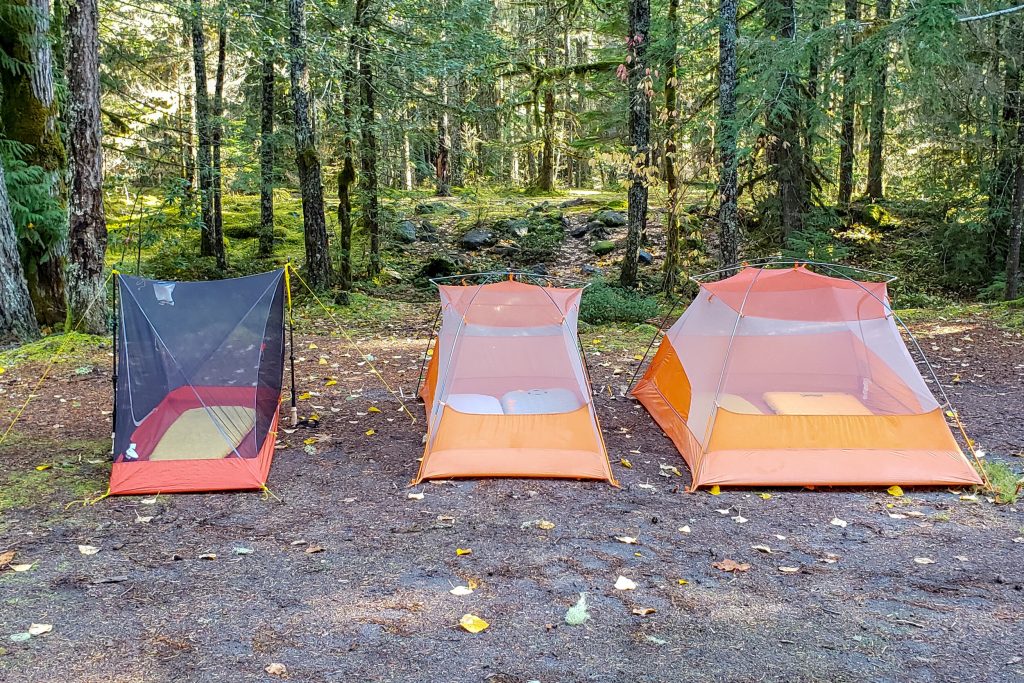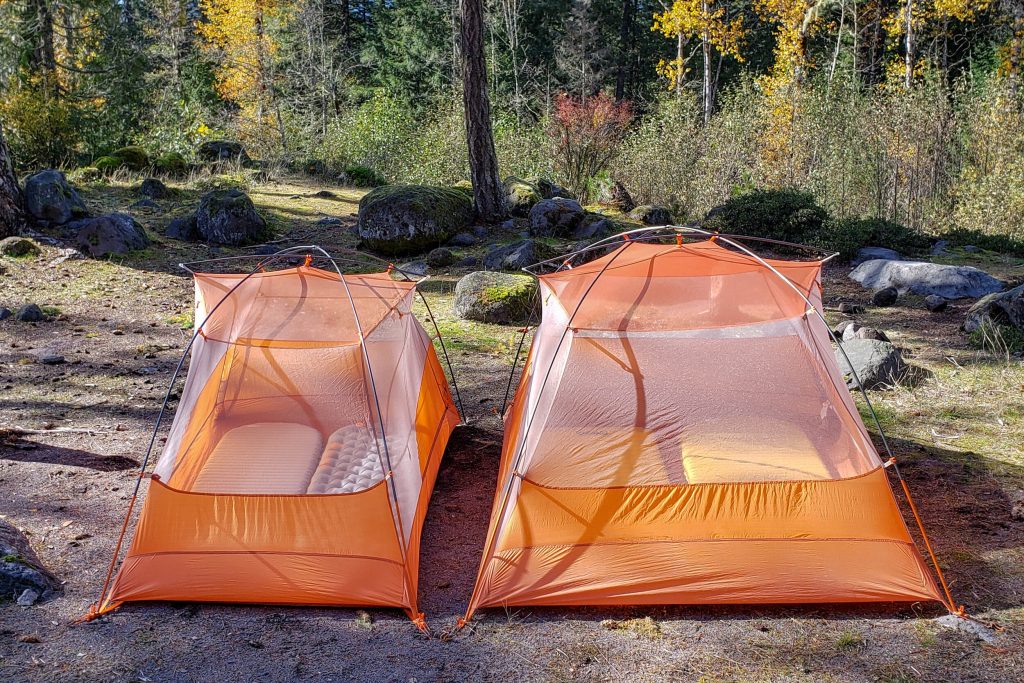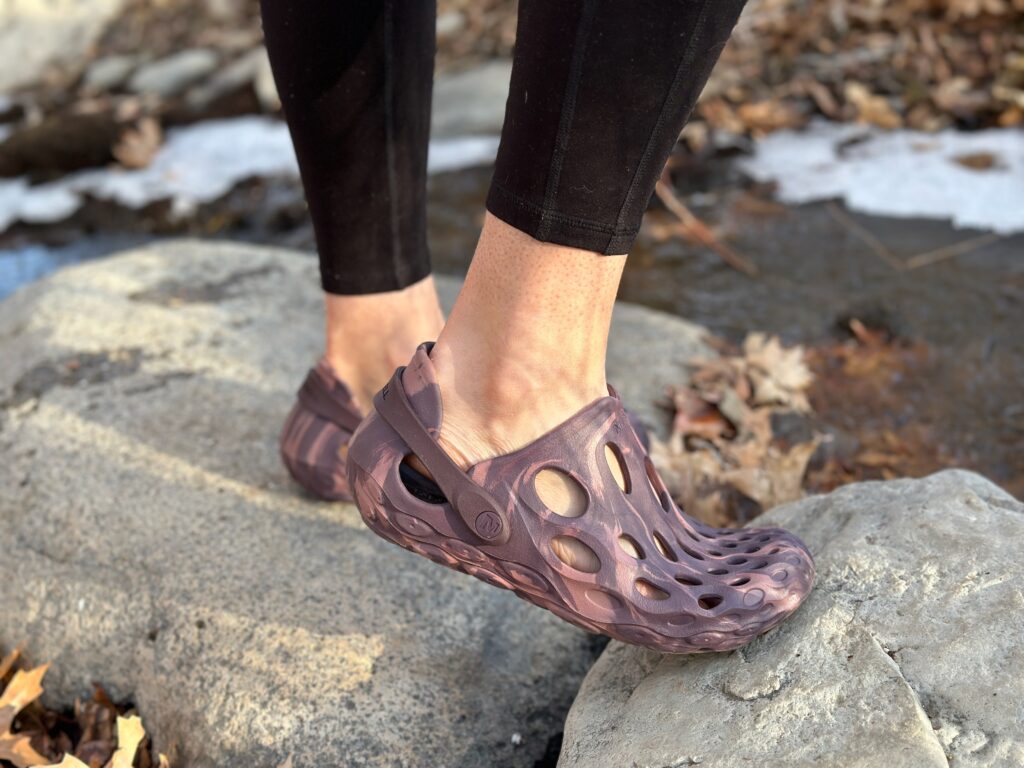
Size is one of the most important considerations you’ll make when choosing a backpacking or camping tent. You’ll want a shelter that’s comfortably spacious, but you’ll also want to balance that against weight, bulk, convenience, and cost.
If you’re looking to buy a new backpacking tent and are on the fence about what size to get, you’ve come to the right place. Here are some tips we’ve drawn from our decades of experience in the outdoor industry that will help guide you towards the best tent models for your next adventure.
Looking for a new tent?
Check out these CleverHiker Gear Guide tent lists:
- 10 Best Backpacking Tents – tents for backcountry travelers
- 10 Best Camping Tents – for those who plan to use their tent primarily for car camping
- 6 Best Budget Tents – for those looking for a solid budget-friendly tent
- 9 Best Ultralight Tents – for those who want to save every ounce possible
- 10 Best Backpacking Hammocks – for those who like to do things a little differently

Backpacking Tent size considerations
Backpacking and Camping tents share many similar characteristics, but backpacking tents come with a special and very important requirement: keeping weight to an absolute minimum. For that reason, choosing an appropriate size for your backpacking tent is a bit more tricky, but very important. The aim is to find a shelter that’s comfortably spacious but also as light and compact as possible.

Capacity Ratings
Most backpacking tents are available in a variety of sizes. For example, the Big Agnes Copper Spur HV UL is offered in 1P, 2P, 3P and 4P capacities.
The capacity rating will give you a good idea of how many people will tightly fit into a given tent, but most users think that tent capacity ratings exaggerate their true size. Said another way: it’s very common for backpacking tents to feel tighter-fitting than their capacity ratings imply.
Generally speaking, this is how most backpacking and camping tent sizes feel:
1P Tents
Usually comfortable for 1 person with gear stored in the vestibule
2P Tents
Luxurious for 1 person with interior gear storage space. A tight fit for 2 with gear stored in the vestibule(s). Will fit 2 regular width sleeping pads (not wide pads).
3P Tents
Luxurious for 2 people with interior gear storage space. Will fit two wide sleeping pads. Comfortable for 2 people plus a small child or dog. A very tight fit for 3 average adults.
4P Tents
Luxurious for 2-3 people with interior gear storage space. Tight but possible to fit 3 people and a child or dog. A very tight fit for 4 average adults.
6P Tents
Comfortable for 4 plus gear. Tight for 5 or 6.
8P Tents
Luxurious for 4 plus gear. Comfortable for 6 if some are children or dogs.
10P Tents
Luxurious for 4 plus gear. Comfortable for 6 plus gear. Tight for 8+ people
Not all 2-person backpacking tents are created equal when it comes to interior space and livability. Below are some recommendations on specific tents and tips to help you accurately guess how a backpacking tent will feel just by looking at its design.
Two regular width sleeping pads (20 inches) will fill most of the floor space of a lightweight 2-person backpacking tent. There will generally be room for 1-2 small stuff sacks stored near your head or feet. The fit of most 2-person tents will feel tight for two people, unless you’re small humans or you’re okay with intimate spaces. If you go with a 2-person size tent, regular width sleeping pads are advised.
One wide pad (25in) and one regular pad (20in) will completely fill the floor width of most lightweight 2-person backpacking tents. The person with the wide pad will dominate the space, but if the pad heights are exactly the same it can work out okay. This usually isn’t a great sleeping pad setup, but it’s doable.
If you want space for two wide sleeping pads (25 in), you’ll usually need to bump up to a 3-person lightweight backpacking tent. Two wide pads usually won’t fit in a 2-person backpacking tent. The upside of going with a three-person tent is that you’ll have a much more comfortable interior space for two people. We prefer three-person backpacking tents for this very reason. The downside to upsizing your tent is that it will weigh more, so make sure to choose a lightweight tent model (more on that below).
If you’re in the market for a new sleeping pad, check out our trail tested list of the 10 Best Sleeping Pads.

2-Person Tent Recommendations
- 2-Person Tents We’d Only Recommend for Solo Hiking
Some 2-person tents, like the NEMO Hornet 2, Big Agnes Fly Creek HV UL 2, and Hyperlite Mountain Gear Dirigo 2 are much tighter than others. Tents with slanted-wall designs like these only have headroom at their center peak, making them feel very tight for two people. In our opinion, these models are best for solo backpackers who want a bigger footprint to store gear and spread out.
- 2-Person Tents That Are Tight, but Still Doable for Two
Some 2-person tents, like the Big Agnes Copper Spur HV UL 2, MRS Hubba Hubba NX 2, NEMO Dagger 2, and SlingFin Portal, have more interior space due to a wide top crossbar that makes the sidewalls more vertical. Tents designed like these offer more headroom for two people sitting side-by-side. These tents are still pretty tight but are suitable for hiking partners who are willing to sacrifice elbow room for a tent that’s compact and lightweight. These tents are a great size for those who plan to do a mix of solo and duo backpacking (with regular width sleeping pads).
- 2-Person Tents That Are True to Size
The only 2-person backpacking tent we’re aware of that’s actually true to size is the REI Half Dome 2 Plus, which offers a generous width to accommodate two people and two wide sleeping pads. That said, the Half Dome is one of the heaviest and bulkiest tents on our Best Backpacking Tents list, so that part is unideal.
- Bumping Up to a 3-Person Tent
Most 2-person backpacking tents are a pretty tight fit for two regular-size adults, so it’s common for hikers to bump up to a 3-person tent size for a little extra interior space. Just remember that keeping weight down is very important for backpacking, so choosing a lightweight model is highly advised if you’re going to bump up in tent size.
Some ultralight 3-person tents we highly recommend are the Big Agnes Copper Spur HV UL 3 and the Zpacks Triplex. Admittedly, the top-of-the-line Copper Spur and Triplex are expensive, but we think they’re well worth the investment for their space-to-weight ratios. If those are out of reach due to price, some more budget friendly (yet heavier) 3-person options are: REI Half Dome 2 Plus or 3 Plus, REI Quarter Dome 3, and REI Passage 3.

When to Go Light & Tight or Upsize for Comfort?
The biggest deciding factors in determining whether to pack the lightest/tightest tent possible or to upsize a little for comfort are.
- Trip type (How strenuous? How long? How much elevation change?)
- Conditions you expect to encounter (Rain, bugs, etc.)
- Relationship and size of hikers (Who’s going and how big are they? How close do you want to sleep?)
- Sleeping pad width (Do you use regular or wide sleeping pads?)
Go Ahead, Upsize!
When traveling in areas where you’re likely to contend with frequent storms or abundant mosquitos, it often makes sense to consider a slightly larger, more spacious tent. When conditions are less-than-ideal you’ll be spending much more time hanging out in your tent, and a tight-fitting tent will quickly feel claustrophobic.
Also, take into account the size of the people sharing the tent, their sleeping pad widths, and the amount of personal space needed to be comfortable. For example, 2 tall male friends sharing a tent on a casual backpacking trip will probably prefer a bit more space.
If you prefer using wide sleeping pads like us (NeoAir Uberlite), keep in mind that most 2-person backpacking tents are too narrow to fit two wide pads. If one person uses a wide sleeping pad and one uses a regular pad, the two pads will usually barely fit, but the wide pad user will dominate the space. The most common solution for wide pad users is to bump up to a 3-person tent (like the Big Agnes Copper Spur HV UL 3) or to find a model that has a little extra width for wide pad users like the REI Half Dome 2 Plus.
Go Light & Tight!
On strenuous trips with lots of elevation gain, the weight savings of packing a lightweight and compact backpacking tent may be worth sacrificing a little extra space. Especially on trips where weather is likely to be fair and you’ll really only be laying horizontally to sleep in your tent.
Also, if you and your partner are on the small side, that might be a nice benefit when it comes to backpacking tents. Smaller adults usually don’t find backpacking tents to feel quite as tight. Hiking partners who are okay with being up close and personal also tend not to mind 2-person tents as much. But be careful, long stints in a tight tent due to lots of rain or ravenous mosquitoes can quickly become claustrophobia-inducing.
Check out our Best Backpacking Tents list for an overview of the tents we recommend and how different sizes compare.

Camping Tents
For camping, weight is less of an issue since you won’t be carrying your tent like you would for backpacking. Because of this, it usually makes sense to size up and get a tent that’s spacious and comfortable for the number of people sleeping in it.
Sadly, camping tent manufacturers also overestimate how many people can actually sleep comfortably in their tents, so it’s a good idea to size up here as well. A general rule of thumb is to subtract two people from the capacity rating of any given tent. For example, if you plan on sleeping a family of four in your tent, it’s probably a good choice to choose a 6-person tent size.
Check out our Best Camping Tents list to see which tents we recommend and how different sizes compare.
Deciding what size tent to get is really important because it can ruin your outdoor experience or help make it amazing.We hope that by seeing these examples and asking yourself the questions above you’ll feel confident in your ability to accurately assess tent sizes, and be able to make well-informed decisions as to what will work best for you. We hope this advice is helpful and that you’ll enjoy some extra versatility, comfort, and freedom on your backpacking or camping adventure!















